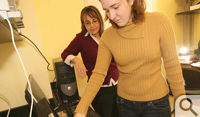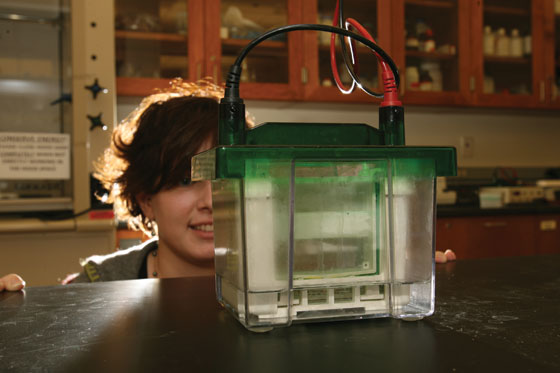Chemistry research in the ISC: Investigating the theft of electrons
Once a year, biochemist Lisa Landino makes a scientific pilgrimage to Virginia’s great pork-packing center of Smithfield, coming home with eight or ten fresh pig brains.
“I know; it sounds lovely,” Landino says. “They’re a buck each, with a minimum of fifty. I only need ten, but I have to pay fifty bucks.” She runs the brains through a blender (“I really do.”), then the “pig-brain milkshake” goes into a centrifuge. The resulting liquid, portioned out and frozen, represents enough raw material to last Landino and her students through a year of intensive investigation of oxidative damage to proteins in the brain.
Many diseases such as Alzheimer’s, Parkinson’s and amyotrophic lateral sclerosis, also known as Lou Gehrig’s Disease, have beginnings in the chemistry of our own body. Landino, associate professor of chemistry at William and Mary, studies the chemical roots of these neurodegenerative conditions. Her lab focuses on oxidative damage to a protein known as tubulin.
Thousands of proteins
Tubulin is only one of the thousands of different proteins in our bodies. Most, if not all, are in some stage of a 24/7 destruction-and-repair cycle involving molecular toxins that our own bodies make.
“We all breathe oxygen. Most of the time, our bodies process the oxygen into water,” Landino said. “But not all of the time.” An unavoidable percentage of the oxygen we breathe is processed into what chemists call reactive oxygen species—molecular structures that are “really quite toxic,” as Landino says.
Reactive oxygen species have chemical structures that are intermediate between O2 and water. “Reactive,” in chemical terms, means that these ions or small molecules have an unpaired electron in their outer—or valence—shells. If nature abhors a vacuum, it hates an unpaired electron with a purple passion. Their unfilled outer electron shell makes them chemically prone to react with something nearby, Landino says, so they “steal an electron” to make their outer shell complete and stable.
Often, the victim of electron theft is one of the body’s own proteins. The electron loss among molecular components of our cells, left unchecked, damages the proteins and, of course, the cells themselves.
The molecular perpetrators of electron theft are also known as free radicals. When you consume food or dietary supplements high in antioxidants, these free radicals are what you are targeting. Landino explained that antioxidants act as molecular sacrificial lambs: “If you eat a blueberry, it gives these reactive species something else to steal an electron from, rather than targeting the proteins in your cells.”
Concentrating on repair
Landino’s work concentrates less on antioxidants and more on the cell’s abilities to repair oxidative damage to its own proteins—especially tubulin. Fifteen to 20 percent of the protein in a neuron is tubulin, she explains, which functions as scaffolding, giving each cell its three-dimensional structure.
“Tubulin also acts as a kind of intracellular railroad track,” she explained, “because some proteins use the tubulin as a walkway to get around inside the cell.”
Landino explained that tubulin exists in two states: a dimer and a polymer. A dimer is a two-part molecule, like two balls of clay stuck together. For tubulin to fulfill its functions as scaffolding and railroad track, the dimers arrange themselves in polymer microtubules, creating hollow filaments made of protein.
The tubulin molecule, she said, has amino-acid “arms” that are vulnerable to electron theft by free radicals. These arms consist of a sulfur and a hydrogen atom, known to chemists as a thiol, or, in chemical notation, as an –SH group. A reactive oxygen ion or molecule, eager to steal an electron, sees these thiol arms as the chemical equivalent of an unlocked car with its motor running.
“If this guy loses an electron, what will commonly happen in a protein is that it now has an S with a little dot,” Landino said. “If two of these S-dot guys are close to each other, they will form a new bond called a disulfide where they are now linked together.” Another result of electron theft could be that two different proteins—each missing an electron—will form an unwanted covalent bond with each other. Enough of this damage, Landino explains, can cause the tubulin filaments to dissolve, the polymer microtubules crumbing into a set of loose tubulin dimers.
“There are proteins that like to associate with these polymer microtubules, and if those proteins don’t have anything to grab onto, it changes the organization of the cell,” Landino said. “And so if you get rid of a main structural component, there’s a blip in time where the proteins don’t know who they’re supposed to interact with. It can be enough to turn on a process called programmed cell death, where cells actually pause and say something’s just not right here. And the cell will begin the process of just…dying. In a disease like Alzheimer’s, if you have a sufficient number of those cells that just die, you start having big holes in your brain.”
In addition, Landino says dissolved tubulin may be implicated in neurofibrillary tangles, the signature protein clumps found in and between neurons of Alzheimer’s patients. The tangles are made up of concretions of a protein known as tau, which normally binds to tubulin.
“My theory is that if something fundamentally bad happens to tubulin, well, then tau’s got nothing to do but bind to itself,” she explained.
The good news, Landino says, is that oxidative damage to proteins is reversible—and usually is reversed. In the case of tubulin, the loose dimers re-assemble into microtubules so that the cell regains its structure and the protein trains begin running on time. The bad news is that, for some reason, oxidative damage to proteins increases as we age.
The problem is aging
“Every cell in your body has some defense against those reactive oxygen species. So you have a number of different proteins in your body that protect you from damage,” Landino said. “But the biggest concern with oxidative damage has to do with getting older. As you age, it’s been shown that you produce more of these intermediates that can be toxic—and you have fewer defenses against them.”
She has the only research lab she knows of that is studying oxidative damage of tubulin, and already has made a great deal of progress in understanding the process. Using off-the-shelf chemicals—and even temperature—she can induce and reverse oxidative damage in the lab, causing the protein microtubules to dissolve into loose dimers and then to re-assemble. At present, Landino’s lab is searching for the specific protein or group of proteins in the neuron that provides the chemical signal for reconstruction.
“The reason I’m interested in this type of damage is that it is reversible. You can make this go back the other way fairly easily. That’s what your body does when it repairs damage normally.”
















